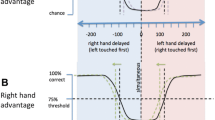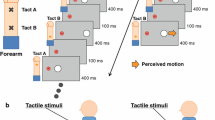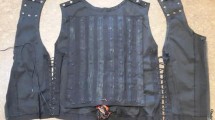Abstract
Purpose: To examine the accuracy and latency of reflexive saccades to vibratory stimulation of the fingertips made by normal human subjects and to compare the findings to those of visually guided saccades. Methods: Eye movements were recorded using infrared oculography. Stimuli were presented via an array of audiometric bone vibrator transducers driven at 250 Hz and positioned at eye level in a darkened room. Target locations were at 0 and ±5, 10, and 15 deg. Visual stimuli were green LEDs. Saccades were analysed interactively off-line and latency and amplitude measured for both types of saccade. Results: Saccades to tactile stimuli had longer latencies and showed less accurate final eye positions than those to equivalent visual targets; they were unaffected by subject age. Error magnitude for the tactile saccades increased monotonically with increasing target eccentricity; because the fingers remained in a fixed position throughout the testing, this also meant that error was lowest for the thumb and increased with progression outwards towards the ring finger. Visually guided refixations were accurate and differed less than 0.2 deg across target locations. Subject age had no effect on performance. Conclusions: Human subjects may make relatively accurate refixations to tactile targets in the absence of visual cues, but only to certain locations/fingers; others were localised very poorly. Further studies are needed to determine whether finger selection or target location is the primary determinant of accuracy in this task.


Similar content being viewed by others
References
Amlot R, Walker R, Driver J, Spence C (2003) Multimodal visual-somatosensory integration in saccade generation. Neuropsychologia 41:1–15
Bahill AT, Adler D, Stark L (1975) Most naturally occurring human saccades have magnitudes of 15 degrees or less. Invest Ophthalmol 14:468–469
Blanke O, Gruesser O-J (2001) Saccades guided by somatosensory stimuli. Vision Res 41:2407–2412
Brandt SA, Ploner CJ, Bernd-Ulrich M, Leistner S, Villringer A (1998) Effects of repetitive transcranial magnetic stimulation over dorsolateral prefrontal and posterior parietal cortex on memory-guided saccades. Exp Brain Res 118:197–204
Gardner EP, Martin JH, Jessell TM (2000) The bodily senses. In: Kandel ER, Schwartz JH, Jessell TM (eds) Principles of neural science. McGraw Hill, New York, pp 430–439
Groh JM, Sparks DL (1996a) Saccades to somatosensory targets. I. Behavioral characteristics. J Neurophysiol 75:412–427
Groh JM, Sparks DL (1996b) Saccades to somatosensory targets. II. Motor convergence in primate superior colliculus. J Neurophysiol 75:428–438
Groh JM, Sparks DL (1996c) Saccades to somatosensory targets. III. Eye-position-dependent somatosensory activity in primate superior colliculus. J Neurophysiol 75:439–453
Jiang W, Wallace MT, Jiang H, Vaughan JW, Stein BE (2001) Two cortical areas mediate multisensory integration in superior colliculus. J Neurophysiol 85:506–522
Kowler E, Blaser E (1995) The accuracy and precision of saccades to small and large targets. Vision Res 35:1741–1754
Lovelace EA, Aikens JE (1990) Vision, kinesthesis, and control of hand movement by young and old adults. Percept Motor Skills 70:1131–1137
Meredith MA, Stein BE (1986) Visual, auditory and somatosensory convergence on cells in superior colliculus results in multisensory integration. J Neurophysiol 56:640–661
Nakamura A, Yamada T, Goto A, Kato A, Ito K, Abe Y, Kachi T, Kakigi R (1998) Somatosensory homunculus as drawn by MEG. Neuroimage 7:377–386
Park S, Holzman PS (1992) Schizophrenics show spatial working memory deficits. Arch Gen Psychiatry 49:975–982
Stevens JC, Choo KK (1996) Spatial acuity of the body surface over the life span. Somatosens Motor Res 13:153–166
Sweeney JA, Rosano C, Berman RA, Luna B (2001) Inhibitory control of attention declines more than working memory during normal aging. Neurobiol Aging 22:39–47
Traccis S, Abel LA, Dell’Osso LF (1984) Audio-ocular response: saccadic strategy. Aviat Space Environ Med 55:735–739
Turano KA, Geruschat DR, Baker FH (2003) Oculomotor strategies for the direction of gaze tested with a real-world activity. Vision Res 43:333–346
Wallace MT, Wilkinson LK, Stein BE (1996) Representation and integration of multiple sensory inputs in primate superior colliculus. J Neurophysiol 76:1246–1266
Zahn JR, Abel LA, Dell’Osso LF (1978) Audio-ocular response characteristics. Sensory Proc 2:32–37
Zambarbieri D, Schmid R, Magenes G, Prablanc C (1982) Saccadic responses evoked by presentation of visual and auditory targets. Exp Brain Res 47:417–427
Zivotofsky AZ, White OB, Das V, Leigh RJ (1998) Saccades to remembered targets: the effects of saccades and illusory stimulus motion. Vision Res 38:1287–1294
Author information
Authors and Affiliations
Corresponding author
Additional information
This research was supported by the Australian Research Council, Canberra, Australia
Rights and permissions
About this article
Cite this article
Sullivan, A., Fitzmaurice, K. & Abel, L.A. Latency and accuracy of saccades to somatosensory targets. Exp Brain Res 154, 407–410 (2004). https://doi.org/10.1007/s00221-003-1749-1
Received:
Accepted:
Published:
Issue Date:
DOI: https://doi.org/10.1007/s00221-003-1749-1




